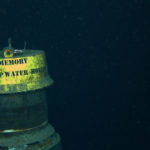There’s a lot of press happening right now about an “unusual mortality event” underway in the northern Gulf of Mexico involving dead dolphins, particularly young ones (see for examples here, here and here). Much of the drama that drives these stories to the front page arises out of potential links to the Deepwater Horizon oil spill last year. It’s important to critically evaluate these sorts of reports, however, and not to allow traditional press/media to create causal relationships for us, based on an editor’s impression of a perceived correlation. So, lets have a look at the data then. Here’s the official word from NOAA:

What I first see when I look at this graph is an annual cycle of mortality in ceteaceans in the northern GoM, with a peak in March (blue columns), then a bad year in 2010, when 3 times as many animals were found as the 02-09 average. For 2011, I see the peak occurring earlier than usual (Feb) but the number of animals per month actually similar to 2010.
What does this mean? Well, to me it means dolphin deaths are not that rare to start with and that this is the time of year for it (i.e. it’s not actually “unusual”, it’s “seasonally-appropriate”). Secondly, it means that it’s not much worse in magnitude than last year, albeit peaking a little earlier. This is important because the Deepwater Horizon disaster didn’t occur until late April, so could not have been responsible for the high numbers in March and April of 2010. To put it another way, 2011 is unfolding much like pre-spill 2010. Thirdly, it suggests to me that NOAA folks could do better with graphing. I say that because to properly interpret this chart, the blue columns representing the average number of deaths 02-09 really, REALLY need error bars! An average on its own is somewhat useless without a measure of spread or variability to go with it. As it stands, the graph makes it look like 2010 and 2011 were way worse than the 8 preceding years, but actaully there might have been equally bad years in that series too, but we can’t tell because the interannual variation is canceled out by years of lower mortality. In other words, important information was lost in the averaging process. I might also ask what qualifies as “unusual mortality event”? NOAA says
“a stranding that is unexpected; involves a significant die-off of any marine mammal population; and demands immediate response.”
All three elements of that definition involve humans! The first – unexpectedness – involves our expectations and therefore a certain subjectivity. The second – significance – is similarly bound up with expectations, unless they mean statistically significant, in which case see my earlier comment about error bars. The third – requiring immediate response – is a real can-of-worms. There can be all sorts of reasons to respond, including public pressure from media hype. Point is, this is not a very objective definition of a UME. I would rather see a scientific definition, something like a monthly mortality value >2 standard deviations above the long term average, or similar.
When I look at what I’ve just written, I can easily see why the science is so often neatly excised from the discussion of these sorts of things in the media; it seems pedantic, and sciencey. It’s so much easier to just syllogize: oil was spilled, dolphins died, therefore oil killed dolphins. But in these cases, the devil IS so often in the details. I am not saying oil wasn’t involved; I’m just saying we can’t infer causality from correlation without a closer examination of the data.






Agree w/everything u say, but I heard (again, no data, just media reports) that:
(1) mostly recently born dolphins were washing up,
(2) that was unusual (that it was mostly recently born dolphins) and
(3) time of conception coincided w/oil spill.
If these 3 “facts” are true, the conclusions you reach from looking at this one graph, sheds no more light on whether this was in fact unusual (or not) or connected to BP oil spill of a year ago.
Perhaps you’re right, but I think the historical context of these events (i.e. the graph) is critical to their proper interpretation. What the data show is that there is a typical seasonal cycle of mortality against which we need to measure these events, and that this complicates things significantly when we’re trying to say what’s “unusual”. For example, what portion of “typical” morts are babies? We don’t have those data, so its hard to determine the significance of that observation. The three points from media reports that you cite are all correlational, not causal. At most, we should see these correlations as important first steps that flag an event that we should investigate further, but they are not at all causal, and IMO this distinction is lost on many journalists and editors. A good example came with the fish kill and bird kill coincidence in Arkansas on New Years Eve; those events were incorrectly linked in the media, but were unrelated events in an unforutnate coincidence. To link these dolphin mortality events to Deepwater Horizon I’m sure we’re going to need more and different data, not just counts but mechanistic links such as tissue residue data or some biomarkers of hydrocarbon exposure. That’s going to take time, which (again) isn’t going to sit well with news media.
Link for the blackbird fish kill thing: http://www.cbsnews.com/stories/2011/01/03/national/main7208349.shtml The blackbirds were killed after taking fright from NYE fireworks. The fish died from an unrelated infectious disease outbreak. They were separated by a couple of weeks and about 125 miles anyway
Look again at the chart. They take 2010, and 2011. Then average those TWO years to come up with the average. DOH.
Ask them to go back 10 years. 5 years. Do your homework. They are conning the American public.
These so called researchers ALL have ties to BP research funding. Paid professional whores. DSN is smarter than this.
Do your research. Do NOT rely on these biased BP propaganda personnel.
What do folks say about statistics? Statistics can be used to validate any point given enough variability in the data. To paraphrase Mark Twain: “Lies, damned lies, and statistics” describe the persuasive power of numbers, particularly the use of statistics to bolster weak arguments, and the tendency of people to disparage statistics that do not support their positions. It is also sometimes colloquially used to doubt statistics used to prove an opponent’s point.
Since NOAA and NMFs have so far failed to analyze any forensic tissue samples from dead dolphins that stranded in 2010 and 2011 in the BP spill zone, and have chosen instead to hide behind a veil of secrecy because of the alleged “criminal” investigation, we must depend on those few observational data they release in graph form. At this point those data are all that we have and will probably have for the foreseeable future. In the meantime, this year’s neonates continue to wash ashore dead in the BP spill zone and all potential mortality factors can be dismissed except the impacts of BP’s oil and Nalso’s Corexit dispersants. When federal officials release “compromised” dolphins back into the same oil- and dispersant-ladened waters of the Gulf of Mexico without collecting live-tissue samples, we must conclude one thing: They will never connect those contaminants with the dolphin deaths!
To know if oil was involved they’d have to do a toxicological analysis on the tissues of the dead dolphins. Any idea if this is being done and if the results will be available? It could be a result of the oil spill if bioaccumulation of pollutants in the dolphins is resulting in some kind of immunosupression rendering them more susceptible to bacterial or parasitic infection. This is something that you wouldn’t notice right after the spill as it requires a certain amount of time to work its way up the food chain to the dolphins. Also, it would be interesting to know the proportion of young since they are always more susceptible and could even have received pollutants directly from their mothers’ milk.
But you’re right, just from looking at the graph it seems that it’s similar to last year but peaking early. And yeah… where are the error bars on the blue columns?! No way this would be published like this!!!
I agree that the involvement of mostly neonates is disturbing and something that is NOT captured by the mortality graph (which groups all size classes). I’m not so sure, however, that we can so easily dismiss “all potential mortality factors … except the impacts of BP’s oil and Nalso’s Corexit dispersants”. I think we should absolutely pursue oil and dispersant as possible explanations, but we shouldn’t close off the possibility that something else is involved, that’s all. I remember a terrible fish kill when I was working in NY that everyone blamed on a new infectious disease (the animals had unusual symptoms). It turned out it was just a chemical spill in a poorly flushed bay. My point is, even when things look cut and dried, sometimes it’s not what it looks like.
NOAA provides data specifically for “baby dolphins.” It shows a five-fold increase in mortalities in 2011 compared to 2010.
Don – could you post a link to this data, please, so that interested people can find it?
Look on http://www.nmfs.noaa.gov/pr/health/mmume/cetacean_gulfofmexico2010.htm and scroll down to the third bar chart. For the first three months of the year, there were 62 mortalities in 2011 and 12 in 2010. For “baby dolphins” there’s a huge increase in 2011. It’s hidden in the data if you look only at the total cetacean mortalities (all species, all ages), as the author of the article did.
As I said in a reply to an earlier comment “I agree that the involvement of mostly neonates is disturbing and something that is NOT captured by the mortality graph (which groups all size classes)”. In fact, the neonate data you link to are confounded in exactly the same way as the all-classes data: by the failure to put error bars on the 02-09 average. Yes, 2011 is a big jump up from 2010, but it’s hard to properly compare against years before that without some information on the variance from 02 to 09, especially when you consider that March is the typically peak season for neonate deaths as it is for all size classes.
All of that is additional to my original point, which was simply that we have to look at and discuss the data, exactly as we are doing in this comment thread, and not jump to conclusions about the CAUSE of these mortalities based on the perceptions of certain elements in the media who, at best, cannot tell the difference between correlation and causation and, at worst, may be trying to beat up a story where one may not exist.
See this guest post by Eric Heupel a couple days after this one that breaks down the data further https://www.deepseanews.com/2011/04/dsn-scientist-in-residence-eric-heupel-revisits-gulf-of-mexico-dolphin-mortality-event/
we should start saving dolphins instead
of throwing trash in oceans and stop capturing
dolphins cause they are mammals like us lots of
related dolphins are dying from being captured
and people in china or japan to stop killing dolphins
But here’s the thing – the definition of “unusual mortality event” is defined in the Marine Mammal Protection Act, which is a policy document, not a international scientific standard. These legal documents are not always highly specific, which is a good thing because it’s not always possible to foresee every possible future event. If you want to see more science in policy, more scientists should get involved.